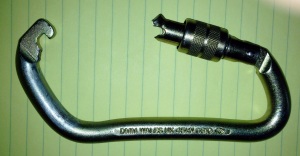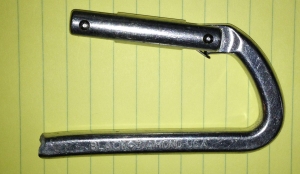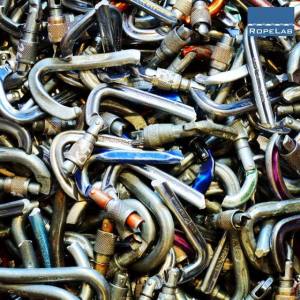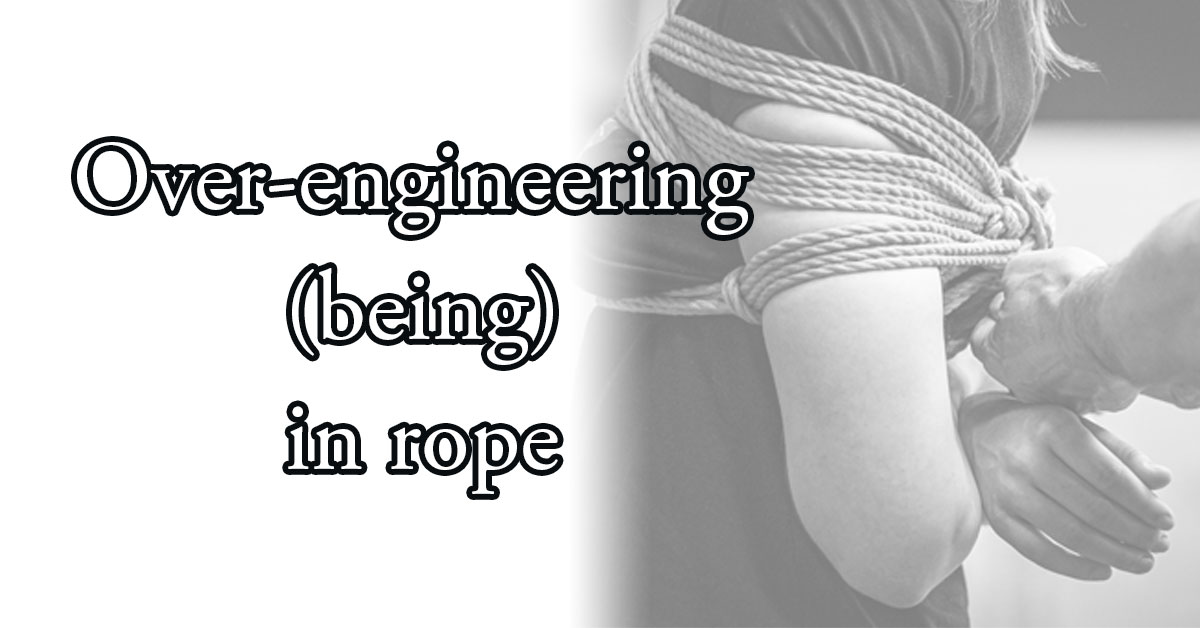Carabineers
A recent carabineer failure at a Circus performance has raised some important questions in the aerial arts community. While I know very little about what caused this particular failure, I want to address some general things about the pros and cons of carabineers and how they fail.
Materials
Carabineers are made of either steel or aluminum. Steel is a very ductile metal – meaning that it deforms (bends and stretches) long before it breaks. This is good because it usually gives the user a chance to see that the metal has been stressed well beyond the working load limits long before it breaks. Aluminum has very little deformation before it breaks (literally snaps); therefore, there is no warning that the metal has been over-stressed. Also, aluminum has “micro-cracks” and imperfections that are impossible to see with the naked eye. I always recommend steel carabineers for aerial work.
This steel carabineer was pulled to destruction. Note how the pin on the gate is torn out. When this occurred, the integrity of the carabineer was lost, and the body began to bend open.
Locking and non-locking gates
The gate of a carabineer not only holds part of the load, but is also critical to the overall strength of the carabineer. What most people do not realize is that the gate of a carabineer can be “popped” open by a shock load, and if this happens, the carabineer immediately loses most of its strength. For example: an aluminum carabineer with a 24 kN BS with the gate closed, is only rated for 7 kN when the gate is open; a steel carabineer rated for 45 kN with the gate closed is only rated for 15 kN with the gate open. To prevent the gate from accidentally opening, I recommend that aerials use carabineers with a locking gate. (I like auto-locking gates because the user cannot forget to lock them).
The gate of this aluminum carabineer “popped” open under a shock load, and the body snapped into two pieces.
Carabineers vs. Shackles
Aerial performers like carabineers because they are easy to connect and disconnect with one hand; they do not have any parts (shackle pins) to drop. However, carabineers are (for the most part) “recreational hardware” and not intended for industrial use. Also, many users of carabineers do not know that the rating on a carabineer is its breaking strength and that 1 kN is equal to 224.8 pounds. The weakest part of a carabineer is the gate (even a carabineer with a locking gate). When a load is on the carabineer, part of the load is held by the gate – it is in tension. Because the gate holds part of the load, the gate should be carefully checked before each use. Check to ensure that the gate is working properly – does it close easily and completely with any issues? Check the “pin” on the gate and the “hook” on the body of the carabineer. If either of these show any damage, or if the carabineer does not close easily and completely, discard the carabineer.
Shackles are industrial hardware. They are rated with a working load limit (WLL) – often in tons. The actually breaking strength is often 5 or 6 times the WLL. Unlike a carabineer, the gate of the shackle (the shackle pin) is in a “double-shear.” Metal is much stronger under a double-shear forge than under tension. Shackles are only made of steel, so they deform long before they fail. You should always check to ensure that the pin of the shackle is not bent and that it screws completely into place in the body of the shackle. If the pin is bent or the pin does not screw completely into the body of the shackle, discard it. Also, “mousing” the shackle pin with wire or a nylon tie is important if the loads swings or is in place for an extended period of time.
What if you drop a carabineer on a concrete floor?
Probably everyone has heard that if you drop a shackle or carabineer on a concrete floor, you should discard it – right? Well, maybe this report from Richard Delaney in Australia might provide some insight into this myth.
I discussed our destructive testing of 100 biners in a thread a while back. We were donated a bunch of alloy bineers that had been ‘retired’ so we dropped them all 5 meters onto concrete 5 times and then gave 20 of these some extra special treatment with a lump hammer to give them the sort of injury that would stop most normal people from using them. Then, we broke them all. All broke at or above rated strength, except one – … this still could have been one of the 3 in ten-thousand that will break low even brand new off the shelf.
Also, I did 3 steel and 3 aluminum a while back that had been dropped 275m onto plate steel over concrete. Aluminum broke above rated; steel were deformed and unusable post drop.
The one in the 100 that broke low was about 10% below rated from memory. Hence, I’m a big fan of reputable manufacturers who proof load all bineers to 1/2 mbs.
Some of the carabineers Richard destructively tested.
To sum this up, if the carabineer is not bent and the gate operates properly after a short drop, it is OK.
Design factors
As noted above, most industrial hardware has a design factor or either 5 or 6, whereas recreational hardware is not rated with a working load limit, but with its breaking strength. When suspending humans, a design factor of 10 or greater is recommended. Even then, that does not guarantee that a failure will not occur.
When possible, there should never be a situation where the failure of a single component can result in a catastrophic failure. In other words, include a backup for every component, and if some component cannot be backed up, make sure the design factor is double what you would normally use and that you inspect it very carefully before every use.
Conclusion
For industrial applications, or where shock loads are common, locking steel carabineers are usually fine for most aerial work if the design factor is 10 or above. Still, careful inspections of all your equipment is the best way to prevent an accident, so inspect, inspect, inspect.
The original blog is here. I considered this information interesting enough to re-post without asking permission (yet). Minor edits have been made to be more directed at the target scene.















Leave A Comment